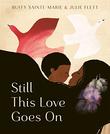Buffy Sainte-Marie has had a long, trailblazing career as a musician, performer, and activist. The Indigenous Canadian American artist won an Oscar for her song “Up Where We Belong,” from An Officer and a Gentleman and has received a string of other awards; TV viewers of a certain age will remember her from a stint on Sesame Street. In recent years she added the title of author to her varied resume, publishing books for children. Her latest is Still This Love Goes On (Greystone Kids, Sept. 27), illustrated by Julie Flett. Sainte-Marie answered a few questions by email.
After a long and varied career in music and activism, what inspired you to start creating books for children?
 I had been on Sesame Street from 1975 to 1981, and when it was time for my son, Cody, to go to school, I began writing a full-length children’s book, Tâpwê and the Magic Hat, which I held back and only released this past June, also from Greystone Kids [with illustrations by the author and Michelle Alynn Clement]. I wrote the story out of love for Cree culture and the fun we have just being kids on a reserve. I wanted other kids beyond the reserve to feel that special “Cree something.” And Greystone has made my dream come true in releasing a separate edition of the book in the Cree language! (It was translated by Cree linguist Solomon Ratt of First Nations University, Regina, Saskatchewan.)
I had been on Sesame Street from 1975 to 1981, and when it was time for my son, Cody, to go to school, I began writing a full-length children’s book, Tâpwê and the Magic Hat, which I held back and only released this past June, also from Greystone Kids [with illustrations by the author and Michelle Alynn Clement]. I wrote the story out of love for Cree culture and the fun we have just being kids on a reserve. I wanted other kids beyond the reserve to feel that special “Cree something.” And Greystone has made my dream come true in releasing a separate edition of the book in the Cree language! (It was translated by Cree linguist Solomon Ratt of First Nations University, Regina, Saskatchewan.)
Hey Little Rockabye actually started out as a song about pet adoption. Previously, I had only sung it to my animals, and I wanted to turn it into a book. For me, the right three-minute song can tell a story that’s as satisfying as a novel but more succinct, simple, and easy for everyone else to learn. The pictures by Ben Hodson illustrate the words perfectly. And I’m very grateful to Greystone Kids and Humane Canada, who used the book and song in their campaign and helped lots of pets find their forever homes.
The illustrations for the new book are by Julie Flett, a Cree–Métis artist. Was it important to you to have an Indigenous collaborator on this book?
Very important. The sentiments in Still This Love could be about anywhere, but the details are definitely set in an Indigenous reserve community. The jingle dancers, the little tracks in the snow, the geese, the beaver dam, the smell of the sweetgrass all share a certain feeling I wanted to give to readers everywhere, and I knew that Julie Flett was familiar with those settings, those people, those experiences. Her other books are just as gorgeous.
Were you a big reader as a kid? Are there any formative books you remember from your youth or any adults who influenced you as a reader or writer?
I’ve always been a biblio-holic, for both print and audiobooks. My mother read to me and loved books, was a proofreader at a newspaper, and we both loved to play with words. I read all theNancy Drew mysteries and haunted the local library.I’ve always loved making up songs and stories that pop into my head, but the only writing book I’ve ever read is Stephen King's On Writing—wonderful. My list of favorite books is really long; it’s at my website. Present classic book crush is The Count of Monte Cristo.
What book released in the past few years deserved more attention?
Andrés Reséndez’s book The Other Slavery: The Uncovered Story of Indian Enslavement in America (2016) is the most impressive book I’ve read in years, with original research about the enslavement of the Indigenous peoples of the Americas. A tough but beautifully written, essential read.
Tom Beer is the editor-in-chief.



































